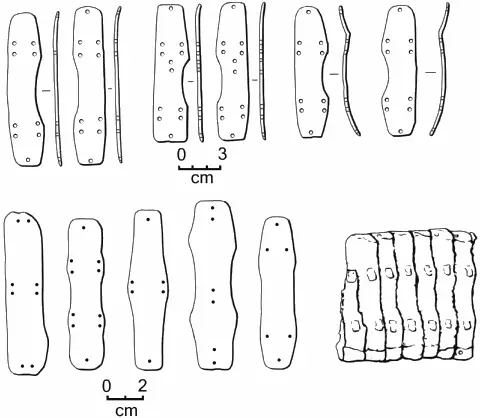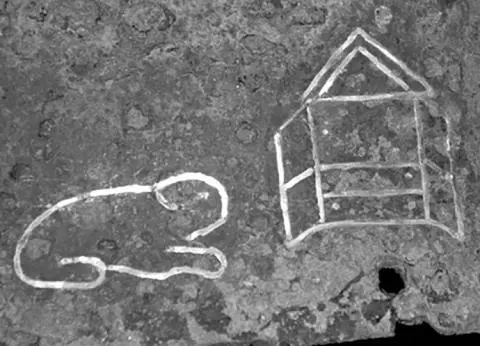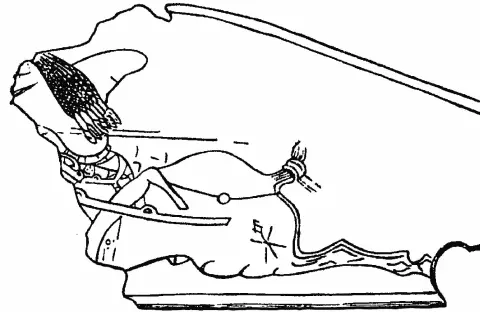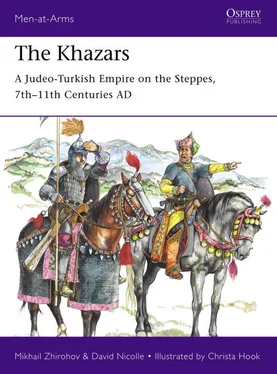Lamellar armour was popular from the Pacific to the Danube, and it was certainly important in the Khazar Khaganate. For reasons which remain unclear, lamellae with curved and scalloped edges fell out of fashion during the 6th and 7th centuries, and had disappeared by the close of the 8th century. What remained were rectangular plates with slightly rounded tops. These were central to the Khazar armourer’s art, and what came next demanded technological skills previously seen only amongst the Romans at the beginning of the 1st millenium AD. (Indeed, such skills only reappeared in Western and Central Europe at the close of the medieval period, though they probably survived in Byzantium.) Khazar armourers learned◦– perhaps from the Byzantines◦– how to connect plates, scales or other forms of lamellae by joining them with iron rivets rather than rawhide thongs. Even more significantly, they used a system of ‘loose riveting’, which required huge skill if the resulting armour was to be both flexible and strong. Such armours were, in fact, almost as flexible as traditional lamellar construction while being considerably stronger, because it was much more difficult to break or ‘pop’ an iron rivet than it was to cut leather, rawhide or silk lacing with a blow from a blade.

Lamellae from Khazar cuirasses made in typical Asian nomad style, found during various unidentified archaeological excavations. (Drawings by A. Karbivnychyi)
Another Khazar development was domed shoulder plates forged from a single piece of steel, which were then strapped to the cuirass◦– a form of protection probably developed from similar shoulder-pieces known in Eastern Turkestan during the 8th century. A cuirass with these ‘pauldrons’ still left most of the arms exposed, along with much of the body and the legs below the waist. To solve this the Khazars wore mail hauberks beneath the lamellar cuirass, in a style of armour that remained characteristic of Central Asia from the 6th century until beyond the end of the medieval period.
Yet another Eastern idea adopted by the Khazars was a pair of greaves forged from two substantial strips of metal connected by loops, almost certainly of rawhide or leather, and secured to the wearer’s shins by buckled straps. Further strips of metal with curved edges could also be riveted to the fronts of such greaves. Comparable greaves appear in Chinese sculptures and wall paintings from the 7th to 9th centuries, as well as in some Central Asian wall paintings of a similar period, and, famously, in some Scandinavian ‘splint’ armour of the immediate pre-Viking era.
Khazar helmets: (1) from Stolbishe; (2) from Sarkel; (3) from Lisiy Gorb; (4) from an unknown location. (Drawings by A. Karbivnychyi)


Decorations on the front and back of the deep brow-band of a helmet found amongst the grave-goods of a Khazar warrior, which suggest that he was of Jewish faith. See also Plate G2. (Private collection)
Helmets
The typical Khazar helmet was made of four segments riveted directly together, plus a conical top element or finial, and often a straight nasal bar. Helmets often also had a mail aventail attached to their rim, reaching the shoulders, to protect the back and sides of the head and neck. Images of warriors in such equipment appear in a number of places, including inscribed bone plates from the Shilovsky mound near the Oka River. A scene of battle on another engraved bone object from the Khazar stronghold of Sarkel portrays a lightly armoured, spear-armed horseman striking a heavily armoured soldier in his only unprotected place◦– his face. In contrast, many Alan helmets appear to have been Spangenhelme made of hardened leather elements attached to an iron frame consisting of a lower rim, eight vertical strips and a plate at the top.
Shields
There is no reliable archaeological data concerning Khazar shields, because their wood and leather are not preserved. However, the nomadic Khazars clearly used the standard Turkic shield of this period, which was round, and usually approximately 78cm (30in) in diameter. It was made of five wooden boards, each 15–18cm (6–7in) wide and not more than 1cm (0.4in) thick. On the inside, these boards were connected to a wooden crossbar. Such a shield could not long withstand the full impact of a cutting weapon; this indicates that the Turks did not rely on their shields in close combat, but primarily used them for defence against arrows.
On a further engraved bone object from Sarkel we see warriors without shields in their hands, though there are round objects which might represent shields lying on the ground. This seems likely, because a warrior who has been struck by a spear has thrown his bow on the ground while his sword also flies from his hand. In one Khazar grave, a slightly domed iron disk with a diameter of about 25cm (9.8in) and a thickness of 0.5cm was found, in the centre of which is a large rivet which had been driven in from the inside. The exact purpose of this object remains unclear, but it may have been used as a small ‘elbow shield’ attached to the arm by a leather strap. Such a defence could only be useful in close combat to deflect a slashing blow.
Horse harness
In a nomadic environment the horse was an essential feature of life, so items of harness were objects of everyday rather than specifically military use. By the end of the 7th century the Khazars were far from alone in using a rigid wooden saddle with stirrups. On the steppes the wood-framed saddle itself dated back to around the 4th century AD, so it is possible, even without the confirmation of archaeological finds, that the Khazars used it from an even earlier date◦– perhaps with leather-loop stirrups, which similarly left no archaeological trace. Metal stirrups first appeared in Central Europe with the Avars in the 7th century, but they only spread more widely across Eastern Europe during the Khazar period.

Surviving part of horse-archer figure carved on decorated bone reinforcing plate of a Khazar-period saddle. Note long braided hair with pendant ornaments; careful depiction of sabre with D-shaped scabbard projections, and floppy end of case for unstrung bow, suspended at his left hip by separate belts; and the stallion’s knotted tail and brand. (Archive of M Zhirohov)
The combination of a rigid wooden saddle and metal stirrups gave greater security to a horseman’s ‘seat’◦– in other words, it was more difficult to knock him off his horse◦– and they also enabled the rider to strike more varied and powerful blows with a range of weapons, especially spear and sword. The stirrup itself had not originally been developed for this purpose, however; in its earliest manifestation it simply allowed a warrior to ride for longer without tiring, by improving circulation in his legs and thus making him less vulnerable to prolonged exposure to cold while in the saddle. In the context of combat, however, rigid saddles and metallic stirrups certainly contributed to the development of the curved sabre and other close-combat weapons, and thus, by extension, to the further development of cavalry armour and helmets.
Читать дальше
















